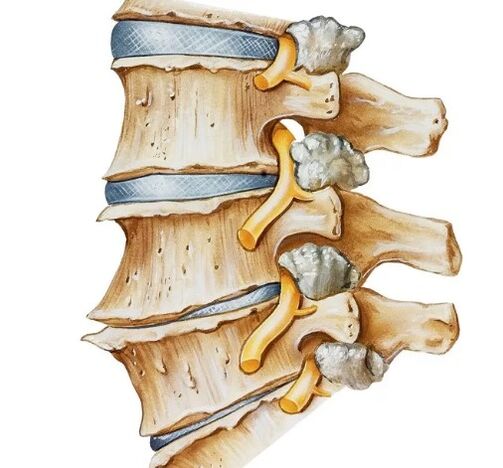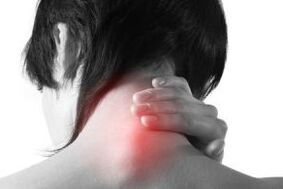TOOsteochondrosis of symptoms and treatment of the cervical columnThey will be different depending on the type of deformation in the cervical vertebrae obtained in relation to a long physical, inflammatory or mental effect on them.

The disease is often chronic, manifested by many clinical symptoms caused by squeezing the nerve roots and blood vessels that come out of the vertebrae. Their compression is due to the wear or deformation of the intervertebral discs (reducing their height, loss of elasticity, deformation of the fibrous ring or breakage). Cervical osteochondrosis is a common disorder that occurs at any age after 20 years.
The reason for the pathology is in the destructive changes in the spine. First of all, changes occur in intervertebral discs: their elasticity, strength and height decrease, their fibrous ring is deformed, the protrusions (the initial stage of intervertebralnia) and the hernias appear. All these changes cause bone growth on the vertebrae (osteophytes), lead to the movement and subsequently - to the loss of mobility of the cervical vertebrae. Since the spine is a flexible protective "case" for the spinal cord, the destructive changes in the intervertebral discs and the loss of the flexibility of the vertebral vertebrae are harmful to the nerve and vascular structures of the spinal cord. They are subject to crushing, movement, which interrupts brain circulation and innervation not only of the cervical and shoulder area, but also of the internal organs, of the lower limbs.
The elder the patient, the more the intervertebral discs have been modified under the influence of age -related muscle housing, long loads on the spine, injuries, slowdown of physical activity, improper posture formation, stressful situations and greater tension in the neck, shoulder dryer, inflammatory disease diseases, etc.

Due to its anatomical structure, the cervical column is more inclined to the pathology, since its vertebrae are more mobile and very tight with each other. In addition, the cervical vertebrae have a weak muscle protection. Very often, degenerative changes develop in the intervertebral discs of the more mobile cervical vertebrae 5. 6, 7.
What are the symptoms of cervical osteochondosis
Diversity and inconsistency of symptoms
Osteochondrosis of symptoms and treatment of the cervical columnIt should be considered complete and together with the type and severity of the degeneration of the intervertebral discs. The signs of cervical osteocondrosis are different and contradictory, since they depend on the location and strength of the manifestation of the deformation process of the intervertebral discs, the peculiarities of the compression or the citation of the nerve roots and the revisions of the blood, as well as the position of the muscles and organs, with them.
Therefore, often the patients' complaints are not addressed to a neurologist, but to other specialists: cardiologist, therapist, otolaryngohra, optometrist, rheumatologist, etc. For example, dizziness complaints, shoulder joint pain in its ears, obscuring in the eyes, patients do not associate vertebrae's pathology. At the same time, a neuropathologist can make a diagnosis of cervical osteochondosis based on the results of a magnetic resonance imaging of the brain and spine, ultrasound of the brain of the brain, ECG, etc.
Tre serie di segni di funzionalità compromessa del sistema nervoso
Gli specialisti esperti conoscono circa trenta opzioni diverse una combinazione di sintomi dell'osteocondrosi cervicale. Non sarà possibile descrivere tutti i segni delle manifestazioni di questa malattia comune, quindi soffermiamolaTre complessiI sintomi principali che caratterizzano alcune funzioni compromesse del sistema nervoso centrale.
Il primo complesso di sintomi di base si applica alle funzioni compromesse della sezione periferica del sistema nervoso. This department is represented by nerves and other elements that are leaving the brain and spinal cord and is divided into somatic and autonomous systems.
In breve, il primo complesso di sintomi dell'osteocondrosi cervicale è presentato sotto forma di varie localizzazione del dolore. Ciò non significa che i segni siano solo dolorosi, spesso i dolori sono combinati con altre funzioni del corpo compromesse. But mainly - these are a constant pain or that occurs periodically in the neck, whose appearance the patient connects with hypothermia, prolonged stress or in an uncomfortable pose, lifting weights, a strong rupture of the head.
I dolori sono doloranti, sparando o simili a uno shock. La loro localizzazione dipende dalla tensione di alcuni muscoli associati a radici specifiche dei nervi, che sono schiacciati dalle vertebre. Pertanto, il dolore può diffondersi nel collo, nuca, spalla, una o entrambe le mani, irradiano sul torace - nell'area del cuore, del fegato. In addition, there are crushing or crackling complaints in the vertebrae of the cervical region when the head moves, as well as the rigidity of the rotational movements of the head.
In the acute start of the disease, the pain and spasm of the neck muscles force the patient to be in a pose with the tilted head and moved away. Arndy pains may appear between the shoulder blades if the cervical vegetative formations are compressed and their blood supply is disturbed. These pains usually increase with physical and emotional stress.
Often there is swelling, pallor and cooling of the hands, their numbness, the rapid heartbeat, pain in the heart, narrowing or expansion of the pupils, etc. Due to the compromise of the short -term observation and the spating region, symptoms of a dystrophic change can occur in the shoulder joint. Patients complain about pain, the inability to lift and take their hand to the side, the rigidity of the shoulder joint.
The second complex of symptoms of cervical osteochondrosis occurs due to the compromise of the spinal cord and manifests itself from engine disorders.
The disorders of the functions of the spinal cord occur due to its compression following the loss of a octopy nucleus from the disc or by injuries with solid discs and outcrops (osteophytes). Depending on the mechanism of exposure to the spinal cord, the following complex of motor disorders is noted: the rigidity of the occipital and cervical muscles, the weakness of the arms and legs, in an increased tone of the leg muscles and a reduction of the tone and weight loss; Loss of temperature and sensitivity to pain; Strong fatigue of the legs, compromised coordination.
The third series of symptoms characterizes blood contribution disorders in the brain vessels and the pathology of the cranial nerves that occur due to deformations in the cervical vertebrae. The symptoms of vascular pathology are manifested.
Characteristic symptoms of vascular disorders:
- neurotic conditions (irritability, desire, anxiety, fatigue, sleep disorders);
- fainting; headache and dizziness; nausea and vomiting;
- noise and ringing in the ears, loss of hearing;
- visual disorders (darkening in the eyes, fog, point, visual impairment);
- Glorious Mining Syndrome (sore throat, a sense of a foreign object, dryness, difficulty swallowing).
The symptoms of cervical osteocondrosis are not unequivocal and should be considered overall and depending on the pathological processes in the spine.
Only a qualified specialist can face the clinical manifestations of this disease, make the correct diagnosis and prescribe the correct treatment of the causes of the disorders detected.
How to treat this disorder
The osteochondrosis of symptoms and the treatment of the cervical column depends on the condition of the patient, on the severity of the disease, on the nature of the damage to the cervical vertebrae.
In the acute period, hospitalization and pharmacological treatment can be requested. They usually use analgesics, muscle blockade of novocaine, muscle relaxants that relieve muscle spasm; Condropropro -propro -production for the nutrition of the cartilage tissue; Sedative drugs that slow down the nervous system, the B vitamins, improving neuromuscular conductivity. The treatment of osteochondrosis of the cervical column is always long and should be complex.
During periods of remission, when acute symptoms are absent, physiotherapy methods (electrophoresis, ultrasound, etc. ), therapeutic physical education, massage and non -traditional procedures, for example acupuncture, are necessarily prescribed.

Many conservative methods of the treatment of osteocondrosis are known, which can stop the progression of the disease. However, each patient needs an individual course of treatment taking into account the stadium of the disease, the characteristics of the body, of the genre and age. The purpose of the treatment of cervical osteochondrosis is:
- Elimination of pain and edema on the inflammation site.
- Relaxation of the neck muscles of the neck.
- The release of blocked nerve roots.
- Increased blood circulation.
- Activation of the metabolism.
- Improve the power of intervertebral discs.
The targeted complex treatment can prevent the occurrence of sports and intervertebral hernias.
In order for symptoms and osteocondrosis and treatment are not launched and the serious complications of the disease must begin to start timely treatment.

























